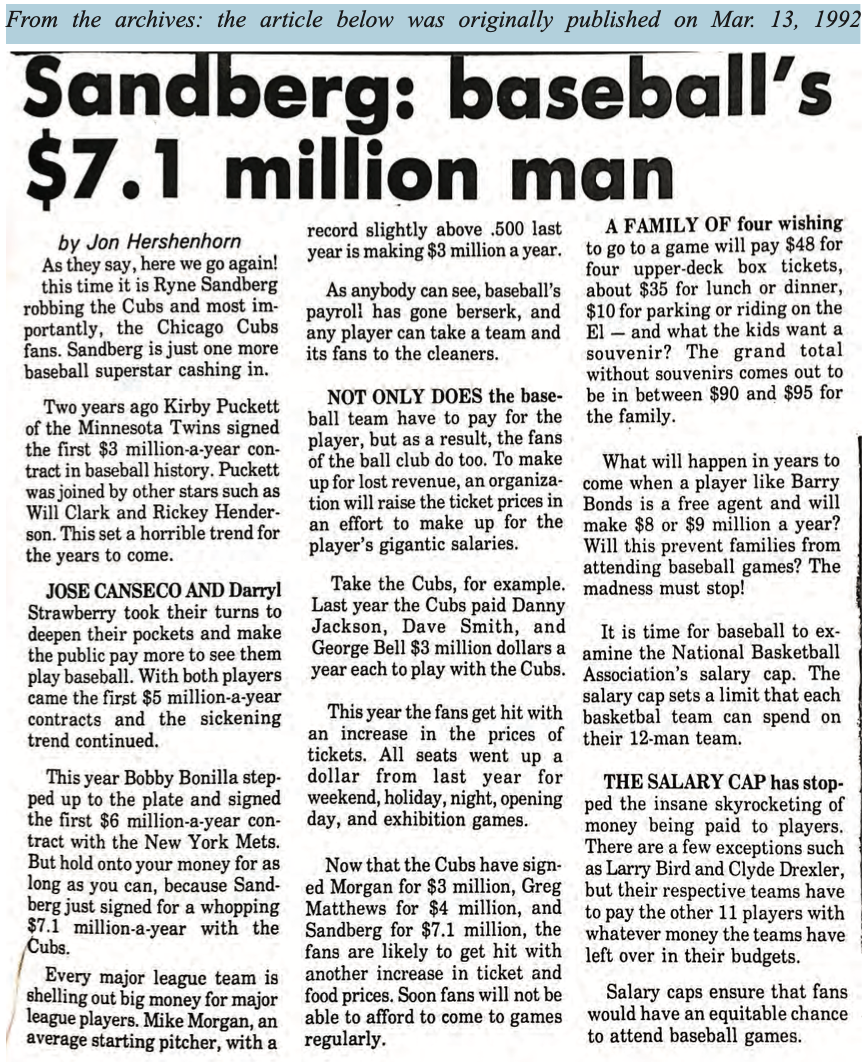Understanding the impact of the Sandberg deal
Although Ryne Sandberg’s four year, $28.4 million contract extension signed on Mar. 2, 1992 seems small in comparison to modern-day player salaries, it was just the latest in a line of record-breaking contracts in the MLB, and it would not be the last.
After the Cubs’ eight-time all-star secured his extension, former New Trier sports editor Jon Hershenhorn predicted that reigning NL MVP Barry Bonds would soon surpass Sandberg’s annual salary of $7.1 million.
While Bonds would become the highest-paid player in baseball in the following offseason, his six- year, $43 million contract with the San Francisco Giants fell short of Hershenhorn’s annual value prediction of $8 to $9 million dollars.
The trend of escalating player salaries that Hershenhorn foresaw continued throughout the 1990’s.
Contracts handed out to superstars such as Ken Griffey Jr, Greg Maddux, Pedro Martinez, Roger Clemens, and Carlos Delgado eventually culminated in Alex Rodriguez’s ten-year, $252 million contract with the Texas Rangers in 2000, which dramatically altered the pay scale for Major League players.
However, while the increase in Major League salaries has led to the uptick in ticket prices that Hershenhorn predicted, the greatest impact of the MLB’s gargantuan contracts lies in the competitive balance of the league itself.
As mentioned in Hershenhorn’s original article, the MLB did not have a salary cap at the time of Sandberg’s contract and still does not have one today.
Teams can choose how much money they devote to player salaries, and the massive revenue streams of big market franchises gives them the financial ability to outbid small market teams for superstar players.
Prominent MLB franchises like the Chicago Cubs, New York Yankees, Washington Nationals, and Boston Red Sox all spent over $200 million on player salaries in 2019, large chunks of which went towards paying star players such as Jon Lester, Giancarlo Stanton, and David Price.
On the other hand, less- recognizable franchises such as Pittsburgh Pirates, San Diego Padres, Toronto Blue Jays, and Tampa Bay Rays had payrolls under $80 million in 2019, which was largely due to the financial constraints that they face as small market teams.
The woes of modern-day small market franchises can even be traced back to the season when Sandberg signed his lucrative contract extension.
The Pittsburgh Pirates, after suffering a third straight loss in the NLCS in 1992, recognized that they would not be able to re-sign Barry Bonds and pitcher Doug Drabek due to Sandberg raising the ceiling of player salaries, so they let both of them walk in free agency and began a postseason drought of 20 seasons the following year.






































